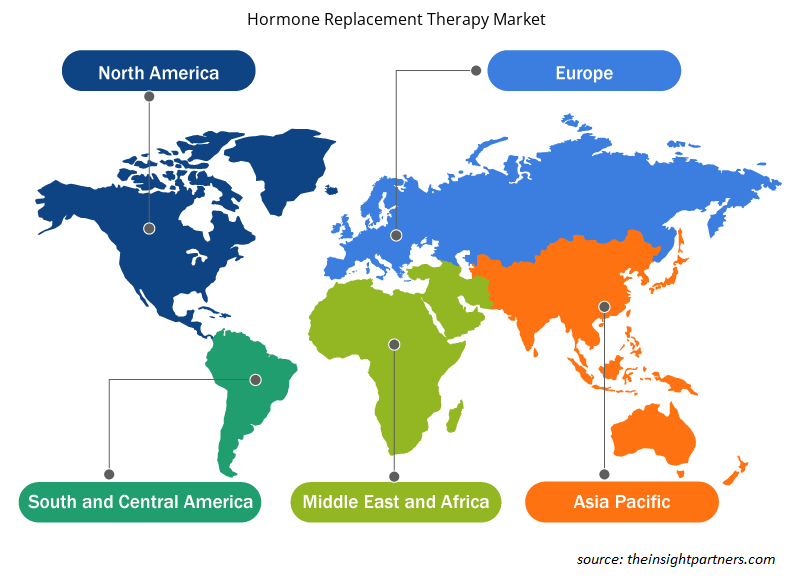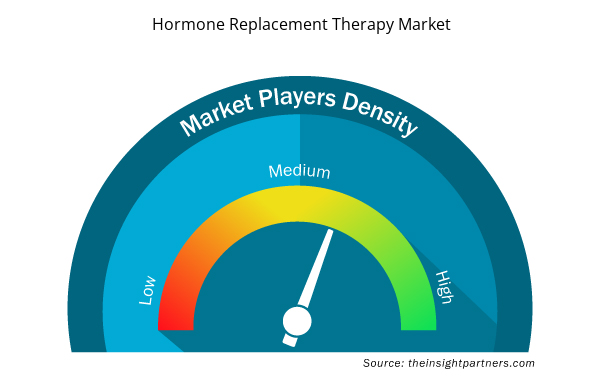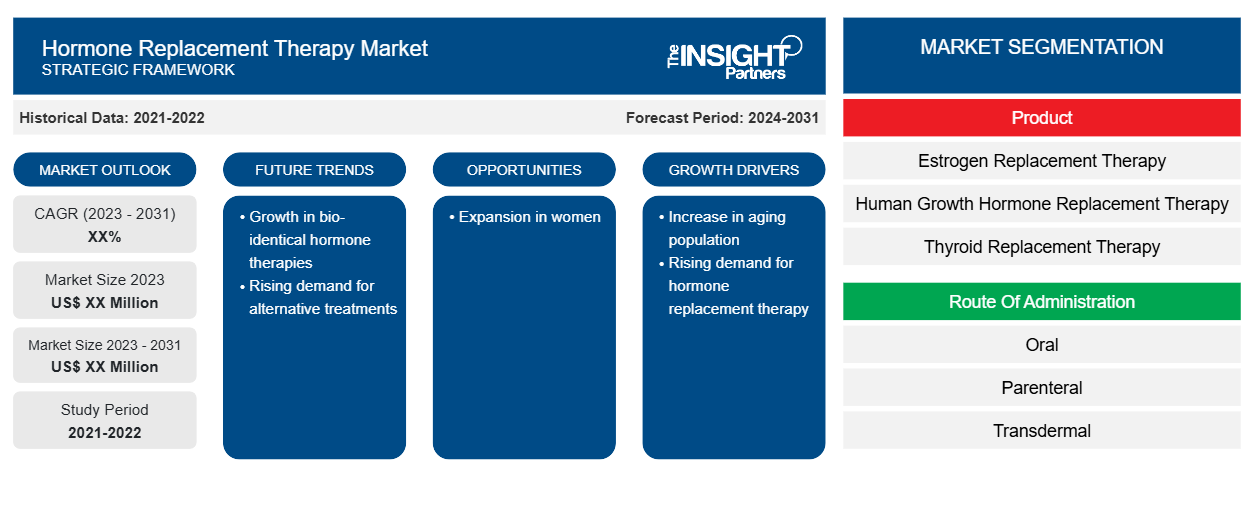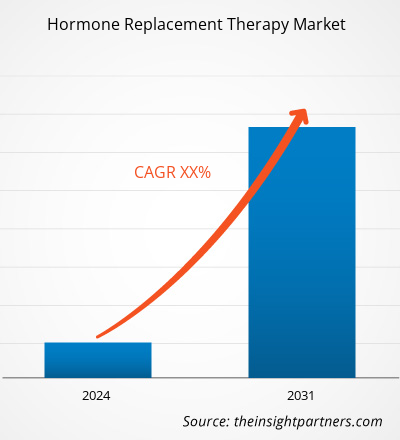Les prévisions du marché de l’hormonothérapie substitutive peuvent aider les acteurs de ce marché à définir leurs stratégies de croissance. Le marché devrait passer de 8,46 milliards USD en 2023 à 14,82 milliards USD en 2031 ; il devrait enregistrer un TCAC de 7,3 % au cours de la période 2023-2031.
La demande mondiale de traitement hormonal substitutif (THS) augmente régulièrement en raison de facteurs tels que la prévalence croissante des troubles hormonaux, la sensibilisation croissante aux carences hormonales et l'amélioration des formulations de THS. En raison de ses avantages apparents en termes de sécurité et d'efficacité, le traitement hormonal substitutif bio-identique (THS) devient plus populaire que les hormones synthétiques. Étant donné qu'il provient de sources naturelles, le THS est censé ressembler davantage aux hormones que le corps produit naturellement.
Les sociétés pharmaceutiques investissent dans le développement de nouvelles formulations d'hormonothérapie, notamment des patchs transdermiques, des gels, des crèmes et des implants sous-cutanés, afin d'améliorer la commodité, l'observance et les profils de sécurité des patients. Ce facteur propulse la croissance du marché de l'hormonothérapie substitutive . En août 2023, la Food and Drug Administration (FDA) a approuvé la demande abrégée de nouveau médicament d'ANI Pharmaceuticals pour le gel d'estradiol à 0,1 %. Le médicament de référence Divigel est une hormonothérapie à base d'œstrogènes utilisée pour traiter les symptômes vasomoteurs modérés à sévères associés à la ménopause. La forme générique de Divigel est le gel d'estradiol à 0,1 %.
Moteurs de croissance :
Une large gamme d'applications stimule la croissance du marché des thérapies de remplacement hormonal
Le traitement hormonal substitutif est prescrit pour traiter les symptômes de la ménopause, le déficit en hormone de croissance, etc., qui peuvent avoir un impact profond sur la vie d'une personne. Des millions de femmes utilisent le THS, parfois pendant de longues périodes. Le THS peut prévenir l'ostéoporose et améliorer la qualité de vie de plusieurs façons. Selon l'Oregon Health & Science University, le déficit en hormone de croissance (DHC) n'est pas courant et touche environ 50 000 adultes aux États-Unis et environ un enfant sur 4 000 à 6 000. Ainsi, l'utilisation croissante de ce traitement, associée à la prévalence croissante de divers troubles hormonaux, stimule la croissance du marché des traitements hormonaux substitutifs.
Retenue:
Le coût élevé des médicaments freine la croissance du marché des traitements hormonaux substitutifs
Le coût des produits de THS est relativement élevé. Par exemple, le prix des ordonnances de traitement hormonal substitutif oral varie de 130 à 240 dollars par mois (soit 1 560 à 2 440 dollars par an), selon le Centre de la ménopause. Le coût élevé empêche l'utilisation régulière de ces produits, ce qui freine la croissance du marché du traitement hormonal substitutif.
Personnalisez ce rapport en fonction de vos besoins
Vous bénéficierez d'une personnalisation gratuite de n'importe quel rapport, y compris de certaines parties de ce rapport, d'une analyse au niveau des pays, d'un pack de données Excel, ainsi que de superbes offres et réductions pour les start-ups et les universités.
- Obtenez les principales tendances clés du marché de ce rapport.Cet échantillon GRATUIT comprendra une analyse de données, allant des tendances du marché aux estimations et prévisions.
Segmentation et portée du rapport :
L’analyse du marché de la thérapie de remplacement hormonal a été réalisée en prenant en compte les segments suivants : thérapie, application, voie d’administration et utilisateur final.
En termes de thérapie, le marché de l'hormonothérapie substitutive est segmenté en remplacement d'hormones œstrogéniques, remplacement d'hormones de croissance, remplacement d'hormones thyroïdiennes, remplacement de testostérone et autres. Le segment du remplacement d'hormones œstrogéniques détenait la plus grande part de marché en 2023.
Le marché de l'hormonothérapie substitutive, par application, est classé en ménopause, déficit en hormone de croissance (GH), hypothyroïdie, hypogonadisme et autres. Le segment de la ménopause détenait la plus grande part de marché de l'hormonothérapie substitutive en 2023 et devrait enregistrer le TCAC le plus élevé au cours de la période de prévision.
Analyse régionale :
Français En termes de région, la portée du rapport sur le marché de l'hormonothérapie substitutive comprend l'Amérique du Nord, l'Europe, l'Asie-Pacifique, l'Amérique du Sud et l'Amérique centrale, ainsi que le Moyen-Orient et l'Afrique. En 2023, l'Amérique du Nord détenait la plus grande part de marché. L'adoption croissante des dernières technologies, la prévalence croissante des troubles hormonaux, l'adoption précoce de nouveaux produits et la présence d'acteurs clés du marché contribuent à l'essor de la taille du marché de l'hormonothérapie substitutive en Amérique du Nord. En juin 2023, NGENLA (somatrogon-ghla), un analogue de l'hormone de croissance humaine à prise hebdomadaire, a été approuvé par la Food and Drug Administration (FDA) des États-Unis pour une utilisation dans le traitement des patients pédiatriques âgés de trois ans et plus qui présentent un retard de croissance causé par une sécrétion insuffisante d'hormone de croissance endogène, selon un communiqué publié par Pfizer Inc. et OPKO Health Inc.
En outre, une attention accrue portée à l’accès à des soins personnalisés de qualité et au renforcement de la solution de soins de santé créerait des opportunités importantes pour le marché de l’hormonothérapie substitutive au cours de la période de prévision. En mai 2023, l’un des plus grands réseaux de cliniques de traitement hormonal substitutif du Texas, Hormones by Design, a été acquis par Forum Health, LLC, le premier réseau national de prestataires de médecine intégrative et fonctionnelle.
Aperçu régional du marché des thérapies de remplacement hormonal
Les tendances et facteurs régionaux influençant le marché de la thérapie de remplacement hormonal tout au long de la période de prévision ont été expliqués en détail par les analystes d’Insight Partners. Cette section traite également des segments et de la géographie du marché de la thérapie de remplacement hormonal en Amérique du Nord, en Europe, en Asie-Pacifique, au Moyen-Orient et en Afrique, ainsi qu’en Amérique du Sud et en Amérique centrale.

- Obtenez les données régionales spécifiques au marché de la thérapie de remplacement hormonal
Portée du rapport sur le marché des thérapies de remplacement hormonal
| Attribut de rapport | Détails |
|---|---|
| Taille du marché en 2023 | XX millions de dollars américains |
| Taille du marché d'ici 2031 | XX millions de dollars américains |
| Taux de croissance annuel composé mondial (2023-2031) | XX% |
| Données historiques | 2021-2022 |
| Période de prévision | 2024-2031 |
| Segments couverts | Par produit
|
| Régions et pays couverts | Amérique du Nord
|
| Leaders du marché et profils d'entreprises clés |
|
Densité des acteurs du marché des thérapies de remplacement hormonal : comprendre son impact sur la dynamique commerciale
Le marché des thérapies de remplacement hormonal connaît une croissance rapide, tirée par la demande croissante des utilisateurs finaux en raison de facteurs tels que l'évolution des préférences des consommateurs, les avancées technologiques et une plus grande sensibilisation aux avantages du produit. À mesure que la demande augmente, les entreprises élargissent leurs offres, innovent pour répondre aux besoins des consommateurs et capitalisent sur les tendances émergentes, ce qui alimente davantage la croissance du marché.
La densité des acteurs du marché fait référence à la répartition des entreprises ou des sociétés opérant sur un marché ou un secteur particulier. Elle indique le nombre de concurrents (acteurs du marché) présents sur un marché donné par rapport à sa taille ou à sa valeur marchande totale.
Les principales entreprises opérant sur le marché de la thérapie de remplacement hormonal sont :
- Pfizer Inc.
- Abbott
- Novo Nordisk
- Société pharmaceutique Novartis.
- Merck KGaA
Avis de non-responsabilité : les sociétés répertoriées ci-dessus ne sont pas classées dans un ordre particulier.

- Obtenez un aperçu des principaux acteurs du marché de la thérapie de remplacement hormonal
Développements de l'industrie et opportunités futures :
Un développement stratégique des principaux acteurs opérant sur le marché de la thérapie de remplacement hormonal, selon les communiqués de presse de la société, est répertorié ci-dessous :
- En janvier 2024, Ascendis Pharma A/S du Danemark et Vector Pharma FZCO (Vector) ont conclu un accord de distribution exclusif pour la commercialisation de Yorvipath et Skytrofa dans les pays du Conseil de coopération du Golfe (CCG) : Arabie saoudite, Émirats arabes unis, Koweït, Oman, Qatar et Bahreïn. Conformément aux conditions de cet accord de distribution exclusif, Vector utilisera son expérience en matière de vente et de marketing pour fournir aux patients des pays du CCG Yorvipath et Skytrofa pour le traitement de l'hypoparathyroïdie chez l'adulte dans le cas de Yorvipath et du déficit en hormone de croissance (GHD) chez l'enfant dans le cas de Skytrofa.
Paysage concurrentiel et entreprises clés :
Astrazeneca ; Pfizer Inc. ; Novartis AG ; Abbott ; Tolmar Inc ; Par Pharmaceutical ; Mayne Pharma Group Limited ; Novo Nordisk A/S ; Eli Lily and Company ; et Noven Pharmaceuticals, Inc. figurent parmi les entreprises de premier plan présentées dans le rapport sur le marché de l'hormonothérapie substitutive. Ces entreprises se concentrent sur le développement de nouvelles technologies, la mise à niveau des produits existants et l'expansion de leur présence géographique pour répondre à la demande croissante des consommateurs à travers le monde.
- Analyse historique (2 ans), année de base, prévision (7 ans) avec TCAC
- Analyse PEST et SWO
- Taille du marché Valeur / Volume - Mondial, Régional, Pays
- Industrie et paysage concurrentiel
- Ensemble de données Excel


- Artificial Intelligence in Defense Market
- Truck Refrigeration Market
- Nuclear Decommissioning Services Market
- Underwater Connector Market
- Virtual Production Market
- Trade Promotion Management Software Market
- Redistribution Layer Material Market
- High Speed Cable Market
- USB Device Market
- Power Bank Market

Report Coverage
Revenue forecast, Company Analysis, Industry landscape, Growth factors, and Trends

Segment Covered
This text is related
to segments covered.

Regional Scope
North America, Europe, Asia Pacific, Middle East & Africa, South & Central America

Country Scope
This text is related
to country scope.
Questions fréquemment posées
By therapy, the market is segmented into estrogen hormone replacement, growth hormone replacement, thyroid hormone replacement, testosterone replacement, and others. The estrogen hormone replacement segment held a larger hormone replacement therapy market share in 2023.
Increasing use of hormone replacement therapy products and increasing prevalence of hormone disorder propel the hormone replacement therapy market growth. However, high cost of medications hampers the growth of the market.
The hormone replacement therapy market majorly consists of the players, including Astrazeneca, Pfizer Inc., Novartis AG, Abbott, Tolmar Inc, Par Pharmaceutical, Mayne Pharma Group Limited, Novo Nordisk A/S, Eli Lily And Company, and Noven Pharmaceuticals, Inc.
Medication that contains female hormones is known as hormone replacement treatment. When you go through menopause, your body stops producing estrogen, so you take medication to replace it. The most common menopausal symptoms that hormone therapy is used to treat are hot flashes and vaginal discomfort.
The market, by distribution channel, is categorized into menopause, growth hormone (GH) deficiency, hypothyroidism, hypogonadism, and others. The menopause segment held the largest menopause market share in 2023, and it is anticipated to register the highest CAGR during the forecast period.
The hormone replacement therapy market is expected to be valued at US$ 14.82 billion in 2031.
The hormone replacement therapy market was valued at US$ 8.46 billion in 2023.
Trends and growth analysis reports related to Life Sciences : READ MORE..
The List of Companies - Hormone Replacement Therapy Market
- Astrazeneca
- Pfizer Inc.
- Novartis AG
- Abbott
- Tolmar Inc
- Par Pharmaceutical
- Mayne Pharma Group Limited
- Novo Nordisk A/S
- Eli Lily And Company
- Noven Pharmaceuticals, Inc.
The Insight Partners performs research in 4 major stages: Data Collection & Secondary Research, Primary Research, Data Analysis and Data Triangulation & Final Review.
- Data Collection and Secondary Research:
As a market research and consulting firm operating from a decade, we have published and advised several client across the globe. First step for any study will start with an assessment of currently available data and insights from existing reports. Further, historical and current market information is collected from Investor Presentations, Annual Reports, SEC Filings, etc., and other information related to company’s performance and market positioning are gathered from Paid Databases (Factiva, Hoovers, and Reuters) and various other publications available in public domain.
Several associations trade associates, technical forums, institutes, societies and organization are accessed to gain technical as well as market related insights through their publications such as research papers, blogs and press releases related to the studies are referred to get cues about the market. Further, white papers, journals, magazines, and other news articles published in last 3 years are scrutinized and analyzed to understand the current market trends.
- Primary Research:
The primarily interview analysis comprise of data obtained from industry participants interview and answers to survey questions gathered by in-house primary team.
For primary research, interviews are conducted with industry experts/CEOs/Marketing Managers/VPs/Subject Matter Experts from both demand and supply side to get a 360-degree view of the market. The primary team conducts several interviews based on the complexity of the markets to understand the various market trends and dynamics which makes research more credible and precise.
A typical research interview fulfils the following functions:
- Provides first-hand information on the market size, market trends, growth trends, competitive landscape, and outlook
- Validates and strengthens in-house secondary research findings
- Develops the analysis team’s expertise and market understanding
Primary research involves email interactions and telephone interviews for each market, category, segment, and sub-segment across geographies. The participants who typically take part in such a process include, but are not limited to:
- Industry participants: VPs, business development managers, market intelligence managers and national sales managers
- Outside experts: Valuation experts, research analysts and key opinion leaders specializing in the electronics and semiconductor industry.
Below is the breakup of our primary respondents by company, designation, and region:

Once we receive the confirmation from primary research sources or primary respondents, we finalize the base year market estimation and forecast the data as per the macroeconomic and microeconomic factors assessed during data collection.
- Data Analysis:
Once data is validated through both secondary as well as primary respondents, we finalize the market estimations by hypothesis formulation and factor analysis at regional and country level.
- Macro-Economic Factor Analysis:
We analyse macroeconomic indicators such the gross domestic product (GDP), increase in the demand for goods and services across industries, technological advancement, regional economic growth, governmental policies, the influence of COVID-19, PEST analysis, and other aspects. This analysis aids in setting benchmarks for various nations/regions and approximating market splits. Additionally, the general trend of the aforementioned components aid in determining the market's development possibilities.
- Country Level Data:
Various factors that are especially aligned to the country are taken into account to determine the market size for a certain area and country, including the presence of vendors, such as headquarters and offices, the country's GDP, demand patterns, and industry growth. To comprehend the market dynamics for the nation, a number of growth variables, inhibitors, application areas, and current market trends are researched. The aforementioned elements aid in determining the country's overall market's growth potential.
- Company Profile:
The “Table of Contents” is formulated by listing and analyzing more than 25 - 30 companies operating in the market ecosystem across geographies. However, we profile only 10 companies as a standard practice in our syndicate reports. These 10 companies comprise leading, emerging, and regional players. Nonetheless, our analysis is not restricted to the 10 listed companies, we also analyze other companies present in the market to develop a holistic view and understand the prevailing trends. The “Company Profiles” section in the report covers key facts, business description, products & services, financial information, SWOT analysis, and key developments. The financial information presented is extracted from the annual reports and official documents of the publicly listed companies. Upon collecting the information for the sections of respective companies, we verify them via various primary sources and then compile the data in respective company profiles. The company level information helps us in deriving the base number as well as in forecasting the market size.
- Developing Base Number:
Aggregation of sales statistics (2020-2022) and macro-economic factor, and other secondary and primary research insights are utilized to arrive at base number and related market shares for 2022. The data gaps are identified in this step and relevant market data is analyzed, collected from paid primary interviews or databases. On finalizing the base year market size, forecasts are developed on the basis of macro-economic, industry and market growth factors and company level analysis.
- Data Triangulation and Final Review:
The market findings and base year market size calculations are validated from supply as well as demand side. Demand side validations are based on macro-economic factor analysis and benchmarks for respective regions and countries. In case of supply side validations, revenues of major companies are estimated (in case not available) based on industry benchmark, approximate number of employees, product portfolio, and primary interviews revenues are gathered. Further revenue from target product/service segment is assessed to avoid overshooting of market statistics. In case of heavy deviations between supply and demand side values, all thes steps are repeated to achieve synchronization.
We follow an iterative model, wherein we share our research findings with Subject Matter Experts (SME’s) and Key Opinion Leaders (KOLs) until consensus view of the market is not formulated – this model negates any drastic deviation in the opinions of experts. Only validated and universally acceptable research findings are quoted in our reports.
We have important check points that we use to validate our research findings – which we call – data triangulation, where we validate the information, we generate from secondary sources with primary interviews and then we re-validate with our internal data bases and Subject matter experts. This comprehensive model enables us to deliver high quality, reliable data in shortest possible time.


 Obtenez un échantillon gratuit pour ce rapport
Obtenez un échantillon gratuit pour ce rapport